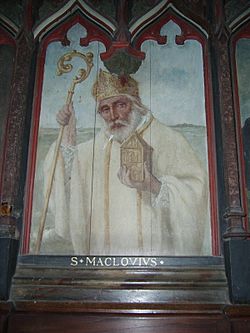Malo (saint)
| Saint Malo of Aleth | |
|---|---|

Saint Malo
|
|
| Born | c. 27 March 501 (487 AD) Traditionally Gwent, Wales |
| Died | 15 November 621 (this may have been the death date of Saint Marcoult) Archambiac, Brittany |
| Venerated in |
Roman Catholic Church Eastern Orthodox Church |
| Major shrine | Saint-Malo Cathedral |
| Feast | 15 November |
| Attributes | Depicted as an abbot and a bishop |
| Patronage | Saint-Malo, pig-keepers, lost items |
Saint Malo [sɛ̃.ma.lo] (also known as Maclou or Mac'h Low, or in Latin as Maclovius or Machutus, born c. 27 March 520 – died 15 November 621) was a mid-sixth century founder of Saint-Malo, a commune in Brittany, France. He was one of the seven founding saints of Brittany.
Saint Malo of Aleth was baptized as an adult by Saint Brendan the Navigator. He became a student of Saint Brendan. As a monk at Llancarfan Abbey in Wales, Saint Malo was known for his participation in the famous Voyage of Saint Brendan. As an Immigrant to Brittany, he helped in the missionary work of Saint Aaron of Brittany, was the First bishop of Aleth (modern Saint-Servan, France) and established churches in the area of Brittany now named Saint-Malo in his honor. Saint Malo of Aleth was later driven from the area to Saintes, France by opponents of his mission.
Details of Malo's career have been preserved in three medieval 'Lives' that seem to include incidents associated with multiple people bearing a similar name. It appears that Saint Malo of Aleth was probably born in Wales in approximately 520.
Malo's name may derive from the Old Breton machlou, a compound of mach "warrant, hostage" and lou (or loh) "brilliant, bright, beautiful".
After his baptism, he became Brendan's favorite disciple. He may have accompanied Saint Brendan on his famous voyage.
Saint Brendan and Malo left Llancarfan Abbey with several companions and discovered the "Island of the Blest". He then went to sea on a second voyage and visited the Island of Cézembre, remaining there for some time. During their travels, they encountered Maclovius, a dead giant whom Brendan temporarily revived with his holiness. Brendan baptized him before the giant returned to his grave. It is thought that Brendan, on the occasion of his second voyage, evangelized the Orkney Islands and the northern isles of Scotland.
...
Wikipedia
